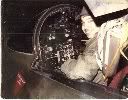Correct me if I am wrong, but are you saying that strategic bombing did not happen until the B-29 came along? Strategic bombing is defined as using airpower as an instrument of military strategy, hence the strategic. Any aircraft that dropped bombs was doing strategic bombing before the B-29's came along.
Setting aside doctrine and mission requirements, wasn't the B-29 just the next step in a long progression going back to the Martin MB-1? As an example, in 1934 General "Hap" Arnold called the Martin B-10 "the airpower wonder of it's day". In 1936 the AAC ordered B-17's because they felt they would fill the long range bomber requirement at that time, B-10's were no longer the "airpower wonder" they used to be. So be it that B-24's took some of the lessons learned from the B-17 and improved on them, bigger payload, longer range, then the B-29 did same, then the B-36, then the B-47 and so on until we get to where we are today.
I am just saying that in my opinion, WWII jet technology (ME-262) had more of an inflence in the future of aircraft than anything else. Even strategic bombers have jet engines and swept wings nowadays.
Here is a website that has the official United States summary report of the bombing campaigns against both Germany and Japan. It's long, but very interesting.
http://www.anesi.com/ussbs01.htm#pagei
Wayners
Go Eagles! 334th Fighter Squadron


Me and my F-4E
<script language="javascript" src="http://www.airfighters.com/phgid_183.js" type="text/javascript"></script>